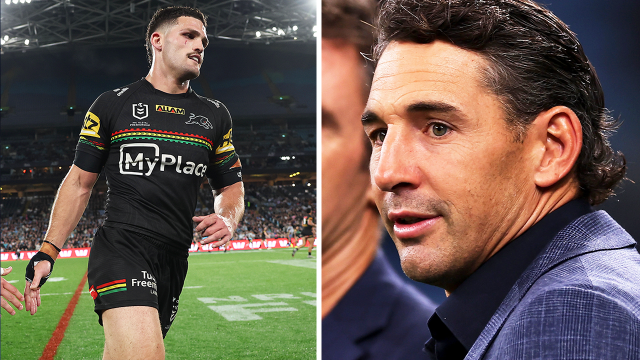In the wake of the NRL Grand Final, tensions are simmering as legendary fullback Billy Slater has taken to the media to voice his concerns regarding Nathan Cleary’s post-game comments. As details of player injuries emerge, Slater’s remarks have sparked a debate about sportsmanship and the integrity of the game.
After the final whistle blew, Cleary, the Penrith Panthers’ star halfback, spoke to reporters about the match, addressing the team’s disappointing performance against the Brisbane Broncos. While his comments primarily focused on the game itself, Slater felt that Cleary glossed over significant details regarding injuries that may have impacted the outcome.
Slater, known for his straight-talking and no-nonsense approach, expressed his frustration during a radio interview. “Nathan needs to be more transparent about what was going on with his team. Fans and players alike deserve to know the truth, especially after a match of that magnitude,” he said. His call for honesty stems from the belief that injuries can significantly alter the dynamics of a game, and players should not shy away from discussing them.
Cleary had mentioned a few injury concerns in passing, but Slater felt that the halfback downplayed the severity of the issues facing the Panthers. Reports have since emerged about key players suffering from various ailments that may have hindered their performance. For instance, it has come to light that Cleary himself played through a shoulder injury, which could have limited his effectiveness on the field.
In response to Slater’s comments, Cleary defended his position during a press conference, insisting that his focus was on the team’s overall performance rather than individual injuries. “We’re all professionals here, and injuries are part of the game. We don’t want to make excuses,” he stated. While Cleary’s sentiment is understandable, Slater believes that acknowledging such challenges is crucial for the integrity of the sport.
The conversation around injuries in rugby league is particularly relevant given the physical nature of the game. Players are often expected to push through pain and discomfort, leading to a culture where discussing injuries can be seen as a weakness. Slater, however, argues that transparency can foster a greater understanding among fans and enhance the narrative surrounding the game. “We need to break that stigma. Players are human, and they face real challenges. Sharing those struggles can help fans connect with the players on a deeper level,” he emphasized.
As the fallout from the Grand Final continues, analysts are dissecting every aspect of the game, including the impact of injuries on both teams. The Broncos emerged victorious, and many believe that the absence of key Panthers players—coupled with the impact of those who were playing injured—played a significant role in the final scoreline. The debate now centers around how openly teams should discuss injuries, especially in high-stakes matches where the pressure is immense.
Former players and commentators have chimed in on the discussion, with some supporting Slater’s call for honesty and others siding with Cleary’s focus on performance. The divide highlights the complexities of the issue. While some believe that players should always be forthright about their physical condition, others argue that maintaining a level of professionalism and not making excuses should be prioritized.
As Slater’s comments continue to resonate, they have reignited conversations about the culture within professional rugby league. Many fans and analysts are now questioning whether the game should implement changes that encourage players to be more open about their physical state. The push for a more transparent approach may lead to greater accountability and a shift in how injuries are perceived within the sport.
Moreover, this dialogue isn’t just limited to the players on the field; it extends to coaching staff and medical teams as well. Coaches must balance the desire to win with the health and safety of their players. Slater’s emphasis on the importance of injury transparency could serve as a catalyst for discussions around player welfare, ensuring that athletes are not only supported during their careers but also after they retire.
As the NRL season progresses, the ramifications of Slater’s comments may lead to a cultural shift within the league. It’s essential for the NRL to foster an environment where players feel comfortable discussing their challenges openly. This could also encourage teams to adopt a more holistic approach to player health, prioritizing well-being over simply putting the best team on the field, regardless of the circumstances.
In the end, the debate surrounding Nathan Cleary’s post-game comments and Billy Slater’s call for greater transparency is emblematic of a larger issue facing professional sports today. The balance between competitive spirit and athlete welfare is delicate, and navigating this terrain requires ongoing dialogue among players, coaches, and fans alike.
As more information comes to light regarding injuries sustained during the Grand Final, the hope is that the NRL can learn from this situation and take proactive steps to ensure the well-being of its players while maintaining the spirit of the game. Slater’s voice, combined with the experiences of players like Cleary, could be instrumental in driving this important conversation forward, ultimately shaping the future of rugby league for the better.

